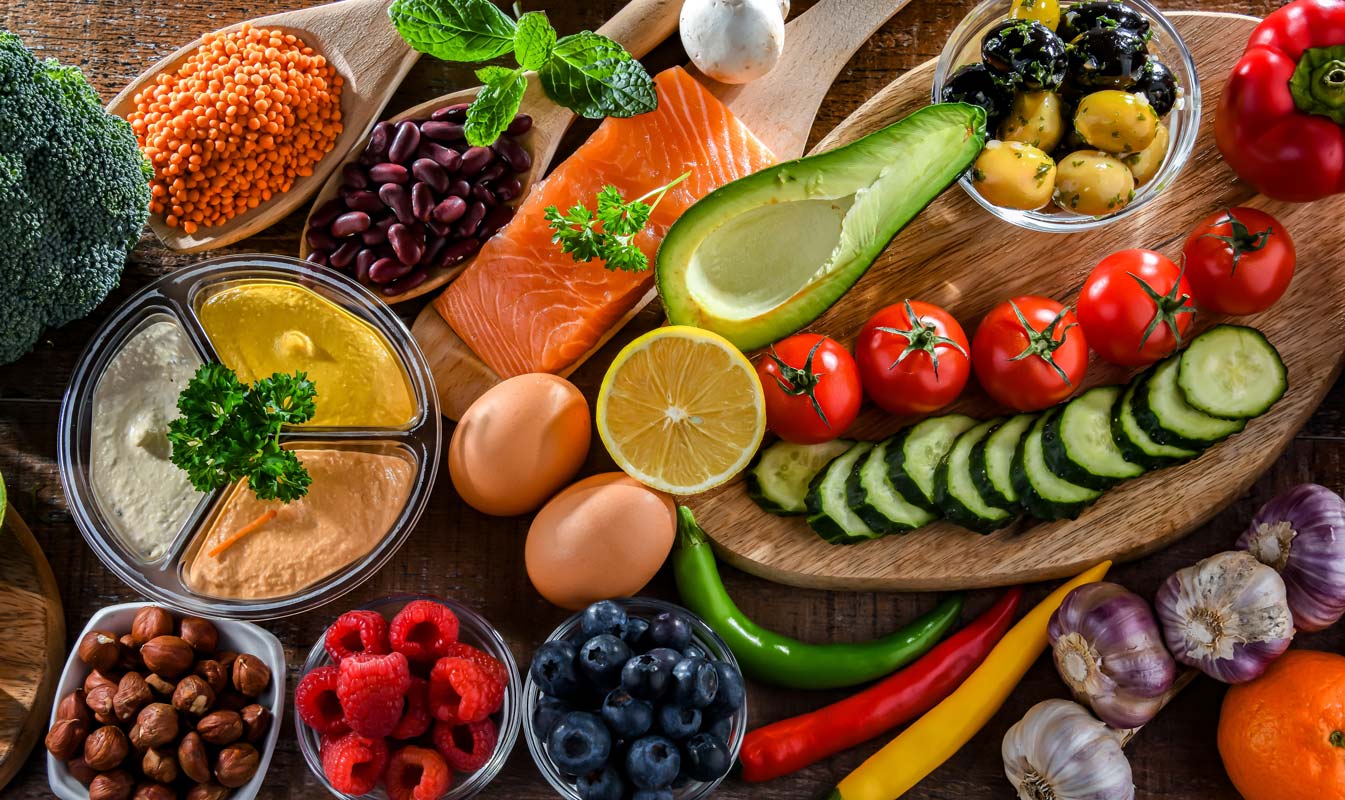Cold Seafood Salad Recipe, Spotlight on Yuzu Rice Wine Vinegar, Overcooking Shellfish, Controlling High Blood Pressure, Plus Exercise and Your Appetite
I love elegant dishes that deliver on taste with a minimum of effort, and my take on a seafood salad is perfect at any time because the ingredients are always available—flash-freezing makes it possible to find them year-round in the freezer case. Another reason to love this dish is that it doesn’t call for any added salt, a contributor to high blood pressure. Read on for other ways to limit sodium in your diet.
Cold Seafood Salad
 Cold Seafood Salad
Cold Seafood SaladYou can enhance this medley, perfect for a light lunch or dinner, with steamed mussels or, for pure indulgence, lobster chunks.
Ingredients
- 1 pound shrimp, peeled and deveined
- 1/2 pound cleaned calamari, cut into rings
- 1 pound sea scallops, preferably the dry type
- 20 cherry tomatoes, halved
- 1 small red onion, cut into rings
- 3 tablespoons extra virgin olive oil
- 1 tablespoon Yuzu Rice Wine Vinegar
- Juice of half a lemon, plus more to taste
- 1/4 cup chopped fresh flat-leaf parsley leaves
- Freshly ground black pepper to taste
Directions
Step 1
Prepare an ice bath: Set out a very large bowl and fill it halfway with water, then add 2 cups of ice.
Step 2
Boil the shrimp in a large pot of water until pink, about 5 minutes; use a large strainer to scoop them out and into the ice bath to cool. Add the calamari rings to the boiling water and cook for 2 minutes; use the strainer to scoop them out and into the ice bath. Turn the heat in the cooking pot down to a simmer, add the scallops, cover, and take off the heat; wait 4 minutes, and then use the strainer to scoop them out and into the ice bath. After 5 minutes, drain the seafood and place in a serving bowl along with the tomatoes and onion rings.
Step 3
Whisk the olive oil, vinegar, and lemon juice in a small bowl. Add the parsley, then pour over the seafood. Toss lightly, taste, and season with pepper and more lemon juice as desired.
Yields 4 servings

Healthy Ingredient Spotlight
Yuzu Rice Wine Vinegar
Each year, as I contemplate the potential vinegar choices for the T. J. Robinson Curated Culinary Selections, I always want to include a rather exotic one to surprise and delight you. Yuzu Rice Wine Vinegar is exactly that.
Rice wine vinegar is such an important ingredient in Asian cooking. It’s made from sake, the beloved rice-based Japanese drink. The sake for this vinegar is American-made, a junmai-grade sake from California. Junmai means that it’s pure—nothing other than rice is added to the fermenting mixture. The rice wine is not seasoned, meaning it has no sugar added; it has just the mellowness that comes from aging.
For a completely one-of-a-kind creation, I had the idea to enhance this vinegar with yuzu. Yuzu is an Asian citrus fruit with a strong perfumed aroma and a highly complex flavor profile with notes of grapefruit, lemon, and mandarin orange—it’s tart, sweet, and floral all at the same time. Its thick and bumpy rind goes from green to yellow as it ripens, and its milky yellow juice has deep flavor. It took a lot of experimenting with proportions to find just the right balance of yuzu juice and rice wine so that both tastes would come through, and then it was rounded out with organic blue agave for a little bit of sweetness. The result is a sweet-tart vinegar with a flavor that will wow you as much as it did me.

Quick Kitchen Nugget
Don’t Overcook Shellfish
No one likes rubbery seafood—one bad experience can turn you off to these gifts from the ocean. It’s especially easy to overcook calamari and scallops since, unlike shrimp, their color doesn’t change dramatically when they’re done. However, they do go from translucent to opaque, often in just a few minutes. If you keep cooking beyond this point, they will become tough. Even if you scoop them out of the cooking liquid, the cooking process will continue until the heat dissipates, which is why I suggest dropping them in an ice bath right away.
Shrimp and whole lobsters will turn a bright red-orange as soon as they’re done. Seafood in the shell, like clams, mussels, and oysters, should be steamed on a rack over simmering water just until their shells open. This can take as little as 5 minutes or up to 10, depending on size, so keep watch. They don’t need the ice bath, but it should be used right away.

For Your Best Health
Controlling High Blood Pressure
Despite strong evidence that salt substitutes can safely lower sodium intake and reduce high blood pressure, very few Americans use them, according to preliminary research presented at the American Heart Association’s Hypertension Scientific Sessions 2025. A new analysis of nearly 20 years of national health data found that usage peaked at just over 5% and then declined, even among those with hypertension. Researchers say this represents a major missed opportunity to improve heart health.
High blood pressure occurs when the force of blood flowing through the blood vessels is consistently too high. High blood pressure can lead to other serious events such as heart attack and stroke. Data from 2017 to 2020 showed that 122.4 million American adults had high blood pressure and that high blood pressure contributed to more than 130,000 deaths. Too much sodium and too little potassium in the diet are risk factors for high blood pressure.
“Overall, less than 6% of all US adults use salt substitutes, even though they are inexpensive and can be an effective strategy to help people control blood pressure, especially people with difficult-to-treat high blood pressure,” said lead study author Yinying Wei, MCN, RDN, LD, and PhD candidate in the departments of applied clinical research and hypertension section, cardiology division, at UT Southwestern Medical Center in Dallas. “Healthcare professionals can raise awareness about the safe use of salt substitutes by having conversations with their patients who have persistent or hard-to-manage high blood pressure.”
Salt substitutes are products that replace some or all of the sodium with potassium. Potassium salt tastes similar to regular salt, except it can have a bitter aftertaste if it’s been heated. Many foods contain some sodium in their natural state; however, the largest amount of sodium comes from processed and packaged foods and meals prepared at restaurants. The American Heart Association recommends consuming no more than 2,300 mg of sodium a day, with an ideal limit of less than 1,500 mg per day for most adults, especially for those with high blood pressure. For most people, cutting back by 1,000 mg a day can improve blood pressure and heart health.
The investigation focused on people with high blood pressure, and an additional analysis was conducted among adults eligible to use salt substitutes, including people with normal kidney function and those not taking medications or supplements that affect blood potassium levels. Some salt substitutes contain potassium, and they can raise blood potassium to dangerous levels in people with kidney disease or those taking certain medications or potassium supplements. Excessive potassium can lead to irregular heart rhythms. People with high blood pressure who are thinking about switching from regular salt to a salt substitute should first consult with a healthcare professional.
The study did have some limitations, said the authors. First, information about salt substitute use was self-reported, so there may have been underreporting or misclassification. In addition, all types of salt substitutes were included in the analysis; therefore, the analysis could not specifically separate potassium-enriched salt from other types of salt substitutes. Finally, the survey data did not capture how much salt substitute the participants used.
“Future research should explore why salt substitute use remains low by investigating potential barriers, such as taste acceptance, cost, and limited awareness among both patients and clinicians,” said Wei. “These insights may help guide more targeted interventions.”
Salt substitutes aren’t the only options for adding more flavor to foods. According to the American Association of Heart Failure Nurses, pure herbs and spices, such as garlic, onion, and chili powder, are great choices. Just make sure you aren’t using garlic salt or onion salt.

Fitness Flash
Exercise and Your Appetite
Researchers at Baylor College of Medicine, Jan and Dan Duncan Neurological Research Institute (Duncan NRI) at Texas Children’s Hospital, Stanford University School of Medicine, and collaborating institutions recently shared new insights into how exercise helps with weight loss. They discovered a mechanism by which the compound Lac-Phe, which is produced during exercise, reduces appetite in mice, leading to weight loss. The findings appeared in Nature Metabolism.
“Regular exercise is considered a powerful way to lose weight and to protect from obesity-associated diseases, such as diabetes or heart conditions,” said co-corresponding author Yang He, PhD, assistant professor of pediatrics-neurology at Baylor and investigator at the Duncan NRI. “Exercise helps [people] lose weight by increasing the amount of energy the body uses; however, it is likely that other mechanisms are also involved.”
The researchers previously discovered that Lac-Phe is the most increased metabolite—a product of the body’s metabolism—in blood after intense exercise, not just in mice but also in people. They had also shown that giving Lac-Phe to obese mice reduced how much they ate and helped them lose weight without negative side effects. But until now, scientists didn’t fully understand how Lac-Phe helps suppress appetite.
“Understanding how Lac-Phe works is important for developing it or similar compounds into treatments that may help people lose weight,” Dr. He said. “We looked into the brain as it regulates appetite and feeding behaviors.”
The researchers studied two types of brain cells in mice: AgRP neurons, which stimulate hunger and are found in the arcuate nucleus of the hypothalamus, and PVH neurons, found in the paraventricular nucleus of the hypothalamus. Normally, AgRP neurons send signals that inhibit PVH neurons, making you feel hungry. But when AgRP neurons are turned off, PVH neurons become more active, reducing appetite.
The team discovered that Lac-Phe directly inhibits AgRP neurons, which in turn activates PVH neurons. This chain of events resulted in the mice eating less. The animals’ behavior remained normal, suggesting that Lac-Phe doesn’t cause unpleasant side effects. “We found that Lac-Phe acts on a protein on AgRP neurons called the KATP channel, which helps regulate cell activity. When Lac-Phe activates these channels in AgRP neurons, the cells become less active,” Dr. He said. “When we blocked the KATP channels using drugs or genetic tools, Lac-Phe no longer suppressed appetite. This confirmed that the KATP channel is essential for Lac-Phe’s effects.”
This research helped explain how exercise can naturally reduce appetite and improve metabolism. “The results also suggest the exciting possibility of targeting this newly discovered mechanism for weight management,” said co-corresponding author Yong Xu, PhD, currently at the University of South Florida.
Although this study focused on mice, the findings are promising for people. Future research will explore how Lac-Phe works in different metabolic states (like obesity vs. leanness), how it travels to the brain, and whether it can be used safely and effectively as a therapy.
Get More Recipes In Your Inbox!









